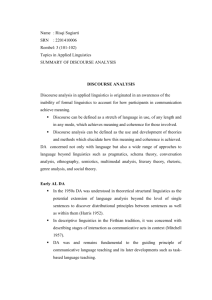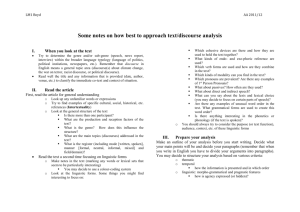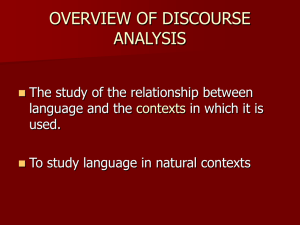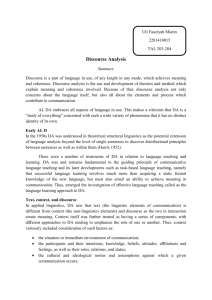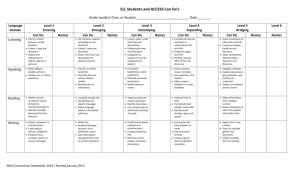Discourse Analysis
advertisement
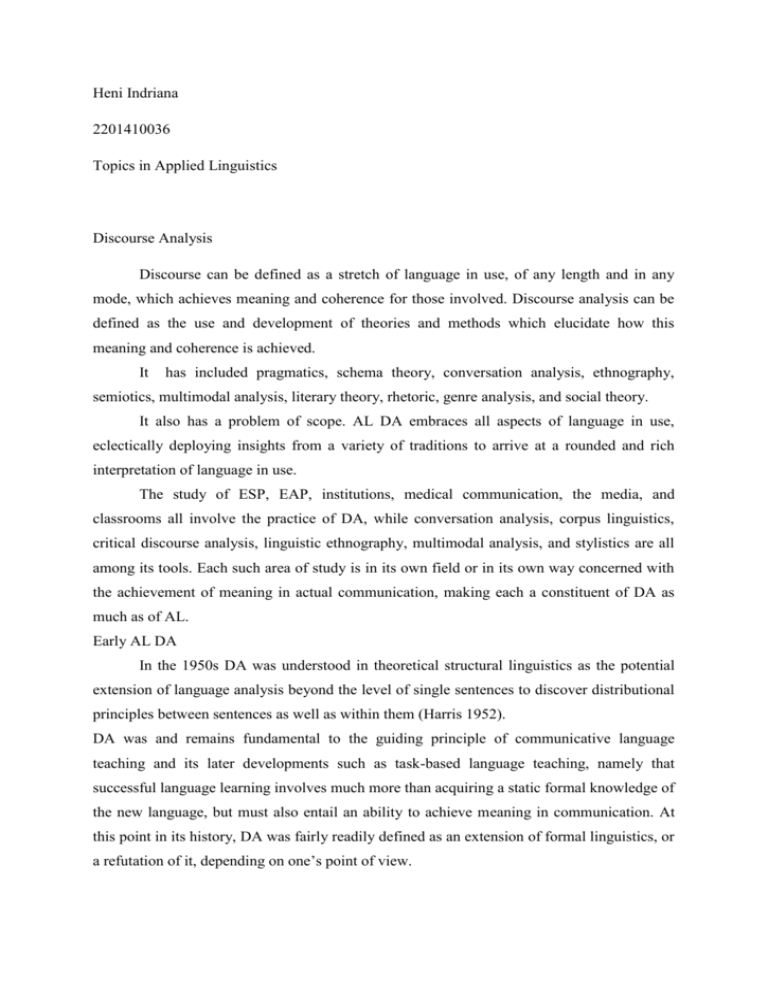
Heni Indriana 2201410036 Topics in Applied Linguistics Discourse Analysis Discourse can be defined as a stretch of language in use, of any length and in any mode, which achieves meaning and coherence for those involved. Discourse analysis can be defined as the use and development of theories and methods which elucidate how this meaning and coherence is achieved. It has included pragmatics, schema theory, conversation analysis, ethnography, semiotics, multimodal analysis, literary theory, rhetoric, genre analysis, and social theory. It also has a problem of scope. AL DA embraces all aspects of language in use, eclectically deploying insights from a variety of traditions to arrive at a rounded and rich interpretation of language in use. The study of ESP, EAP, institutions, medical communication, the media, and classrooms all involve the practice of DA, while conversation analysis, corpus linguistics, critical discourse analysis, linguistic ethnography, multimodal analysis, and stylistics are all among its tools. Each such area of study is in its own field or in its own way concerned with the achievement of meaning in actual communication, making each a constituent of DA as much as of AL. Early AL DA In the 1950s DA was understood in theoretical structural linguistics as the potential extension of language analysis beyond the level of single sentences to discover distributional principles between sentences as well as within them (Harris 1952). DA was and remains fundamental to the guiding principle of communicative language teaching and its later developments such as task-based language teaching, namely that successful language learning involves much more than acquiring a static formal knowledge of the new language, but must also entail an ability to achieve meaning in communication. At this point in its history, DA was fairly readily defined as an extension of formal linguistics, or a refutation of it, depending on one’s point of view. Text, context, and discourse Context itself was further treated as having a series of components, with different approaches to DA tending to emphasise the role of one or another. Thus, context variously included consideration of such factors as: the situation or immediate environment of communication; the participants and their intentions, knowledge, beliefs, attitudes, affiliations and feelings, as well as their roles, relations, and status; the cultural and ideological norms and assumptions against which a given communication occurs; language which precedes or follows that under analysis, sometimes referred to as ‘cotext’ (Halliday et al. 1964); other texts evoked for the participants and affecting their interpretation – sometimes referred to as ‘intertext’ (Kristeva 1986); non-linguistic meaningful communicative behaviour, i.e. paralanguage, such as voice quality, gestures, and facial expressions (in face-to-face spoken interaction), and choice of typeface and letter sizes (in writing); use of other modes of communication accompanying the use of language, such as music and pictures; the physical medium of communication, such as speech, writing, print, telephone, computer. Early DA did, however, often work with this binary text/context distinction. This was understandable. For the applied linguists of that time, trained as they were in more traditional linguistics, DA was indeed experienced as the addition of a new dimension (i.e. context) to their existing object of study (i.e. text). Pragmatics Pragmatics was put to good to use in discourse analysis of realworld extended communication. In a landmark work analysing the discourse of primary school lessons, Sinclair and Coulthard (1975) used the pragmatic notion of the act as a fundamental unit of analysis, showing how acts combine to form higher units (which they called moves, exchanges and transactions) in an attempt to formulate rules analogous to those in structural grammars. Schema theory Schema theory is a powerful tool in DA as it can help to explain both high level aspects of understanding such as coherence, and low level linguistic phenomena such as article choice. Both pragmatics and schema theory have remained salient in many approaches to DA. But their focus is very much on understanding as a product, explained after the event, rather than a process. Conversation analysis CA made use of newly available recording technology to transcribe and closely analyse actually occurring conversation, seeking to understand how participants ‘make sense of, find their way about in, and act on the circumstances in which they find themselves’ (Heritage 1984: 4) and through this close analysis to understand the patterns of social life (Bhatia et al. 2008: 4) as realised in talk. Ethnography, language ecology, linguistic ethnography Ethnography is firmly committed to seeking significance in the details and apparent disorder of everyday communication, and understanding participants’ own perspectives on the meaning and dynamics of what is happening. linguistic ethnographers draw upon a number of precedent influences, such as new literacy studies, interactional sociolinguistics, and critical discourse analysis (see below), as well as the mainstream applied linguistics language learning approach to DA. linguistic ethnography seeks to relate language use to its physical and social environment, and the affordances this environment provides. It sees language as a historically contingent phenomenon negotiated in daily interactions, and pays particular attention to the dynamic relation of language and cultural change, historical expansion, displacement (e.g. by migration), continuity, and transformation. Semiotics, paralanguage and multimodality Despite their very different origins and approaches, the approaches described so far have worked with brief invented dialogues or transcripts of recorded actually occurring talk. None, however, makes more than a limited and unsystematic reference to communicative channels other than language. The exploitation of paralanguage in spoken communication is an instance of multimodality as it involves visual, non-linguistic sound, and other sensory stimuli. Closely related to the increased attention to paralanguage in discourse analysis of talk, therefore, are recent advances in the analysis of multimodal communication in general, and the growing awareness that language cannot for DA purposes be analysed in isolation from other communicative elements. Multimodal meaning, whether in speech or writing, should then be an essential element of any DA, as it plays a major part in human linguistic communication. Multimodal elements in communication, because they are graded rather than discrete signs, cannot be simply reduced to linguistic terms as they were in early semiotics (Barthes 1977; Kress and van Leeuwen 1996). Larger structures Despite their differences, all of the approaches discussed so far have an important element in common. Though they may aim for, and obtain, far reaching conclusions about communication, culture and society, they take as a starting point a fine-grained analysis of language in use, assembling evidence of what happens in instances of communication, before making generalisations. Genre analysis One such approach is genre analysis, which seeks to understand any communicative event as an instance of a genre, defined as ‘a class of communicative events which share some set of communicative purposes’ (Swales 1990: 58). Examples of genres are such events as academic articles, news bulletins, advertisements, prayers, operas, menus. Genre analysis then seeks, through fine-grained analysis, to identify the conventions which characterise these different genres. Critical discourse analysis (CDA) CDA is concerned with ideology, power relations and social injustices, and how these are represented and reproduced through language. They may focus primarily upon discourse practices and ideologies, or seek to link discourse and social structures, or to situate specific discourses such as those of racism within a broader historical perspective. Back to detail and forward to generalisation: corpus linguistics The advent of corpus analysis, however (see Adolphs and Lin, this volume) has enabled DA partially to redress these shortcomings, and to add a quantitative dimension to research. With its power to place any particular instance of language in the context of its use across a wide range of comparable texts or the language as a whole, corpus comparisons have enabled discourse analysts to talk with confidence about the typicality of any text under consideration. Corpus linguistics, like other forms of linguistic analysis before it, is an invaluable tool for DA. Final word The question touched upon earlier, however remains, and becomes more acute as the resources available multiply: whether discourse analysis still has any identity separate from the many traditions on which it has drawn. While it may be commendable to draw eclectically upon the strengths of many research traditions to gain a rich insight into communication, there is a valid case for saying that there is no longer a single theory or method of analysis which can be clearly labelled as discourse analysis. Questions : 1. What is differences among text, context, and discourse? 2. Is discourse analysis used in teaching and learning process?

